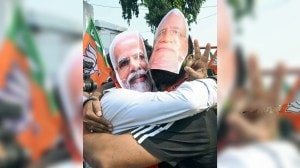Click here to follow Screen Digital on YouTube and stay updated with the latest from the world of cinema.
Exploring reality
Sohini Dasgupta’s first feature, Chhoti Moti Baatein, was the sole entry at the International Competition for Women Directors at the recently-concluded 20th KIFF in Kolkata. The director talks about her film that throws up an unusual perspective on a real-life tragedy.
 Tannishtha Chatterjee, Kulbhushan Kharbanda and Ananya Chatterjee in a still from Chhoti Moti Baatein
Tannishtha Chatterjee, Kulbhushan Kharbanda and Ananya Chatterjee in a still from Chhoti Moti Baatein
By Shoma A. Chatterji
In June 2012, two sisters were discovered from their Noida flat. They were on the verge of having starved themselves to death, as they had shut themselves in the apartment for many months. Is your film based on this tragedy?
I read the news in the newspapers. I saw the pictures and was really moved. The incident kept haunting me because this self-isolation for a long time and yet their coming out alive was intriguing. Why did they do this? How did they survive? Why did no one notice the disappearance? These questions disturbed me. I began to build a fictional narrative on the basis of these questions and this became the core of my film. My film does not deal with real issues like self-starvation or anorexia. It deals with the conflict between spaces, open and within, the conflict between nature and concrete reality, the inner and outer spaces people move in. These form the basis of my story.
Is there a message you are trying to get across?
I do not believe in messages in my film. It does not deal with tragedy. It is an open-ended, linear narrative. The two girls, Rita (Ananya Chatterjee) and Chhoti (Tannishtha Chatter-jee) are shown exploring this new enclosed space they shut themselves in, which for them, becomes a cocoon, a world in miniature that liberates them as they find harmony and peace in nature. The film subtly critiques the social dilemma about two so-called unconventional women, two thirty-something unmarried sisters who live together, the dichotomy in people becoming reclusive in the age of super networking and communication. The film tries to present the power of nature and love.
You have introduced nature in a very different way in the film. Is this a surrealistic intrusion into the narrative?
When I read about the incident, the first thing that struck me was the surreal, absurd elements that were open to exploration. If reality is so surreal then why try projecting it in an all-real way? I wanted to get into the mystique of the sister’s story and made them re-discover a space they did not know exists and make it their own. I read this as the inner reality of the sisters and not reality as we conventionally understand it. Their lives change dramatically when a sapling grows in a crack in the wall and becomes a tree with birds flying in, making Nature a real presence in their lives.
Would you call this a woman-centric film?
Just because I happen to be a woman, it does not mean that I will veer towards subjects centred on women. In cinema your artistic self dominates, not your gender. It is important to be humane and human before being a film-maker, man or woman, does not make a difference.
How did you go about casting Ananya and Tannishtha as the two sisters while in reality, the two sisters were a bit older?
My film is a work of fiction. So I shaped and fleshed out the characters the way it coincided with my conception and my script. They did not need to be like the real sisters. I made other changes too. The NOIDA sisters had a brother who lived away from them. I kept that away because it did not belong to my film. I consider myself lucky to have powerful performers like Kulbhushan Kharbanda, Ananya and Tannishtha for my cast and they have been wonderful all the way.
How much have you imbibed from your mentor Buddhadev Dasgupta, with whom you have worked for a long time?
His role in my life has been that of a university in a student’s life. We are also great friends. I was shaken and awe-truck by his films from much before I met him. He is undoubtedly my favourite. He has influenced me greatly as an artist and working with him for eleven years has helped me grow every moment. It has helped me discover my own language and expression of cinema, important for every aspiring film-maker.


- 01
- 02
- 03
- 04
- 05
































